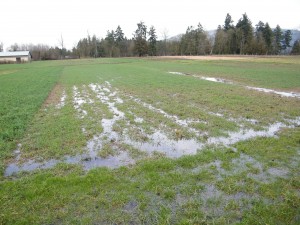I love winter on the farm. Not for the weather, but for the natural opportunity it allows us to take stock of the past year and plan ways to improve the following year.
 Every year at this time we work on how to better manage the water that flows across our farm in the rainy months. Without a good plan, you can lose your fertile topsoil and the muddy water leaving your property can harm the water quality in our streams and rivers.
Every year at this time we work on how to better manage the water that flows across our farm in the rainy months. Without a good plan, you can lose your fertile topsoil and the muddy water leaving your property can harm the water quality in our streams and rivers.
There is a lot you can do to help control soil erosion. Here are a few simple things to get you started:
- Take pictures of where the water runs on your property during rainstorms (usually until April). This way, you’ll remember where the problem areas are.
- Plan to plant a cover crop to ensure those areas are not left bare next winter. Cover crops, such as fall rye, are planted in the late summer to early fall. These plants’ roots will hold your soil in place during the rainy season. You can work them back into the soil in the spring before planting your garden.
- Make a planting plan so your cover crops have time to become established before the winter. A mistake we once made was planting winter squash in a problem area. The squash didn’t mature until October, which didn’t leave our fall rye enough time to send down strong roots. Instead, plan now to reserve the problem areas for crops that will be harvested no later than the end of September, such as bush beans.
If you’re dealing with soil erosion right now, try using bales of hay to help direct and slow down the water, catching some of the sediment before it leaves your property. Then get out your camera and calendar, and make a plan so you’re ready for next winter.
